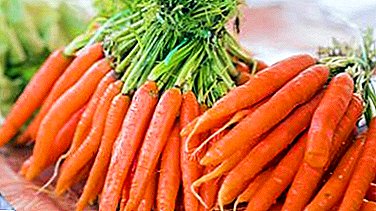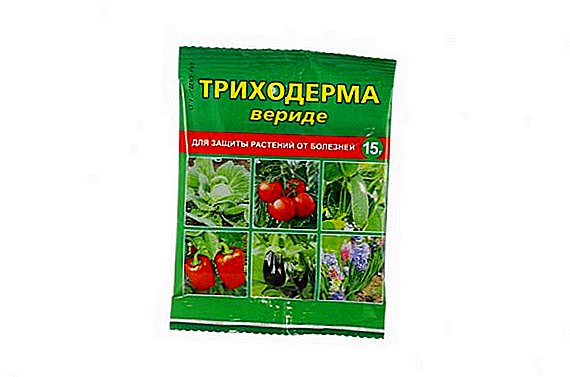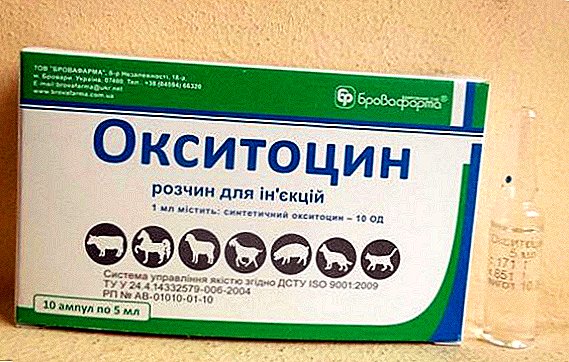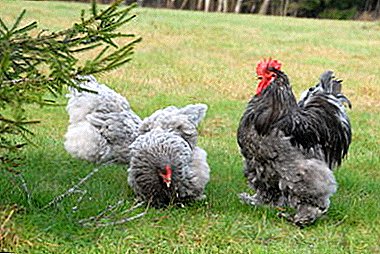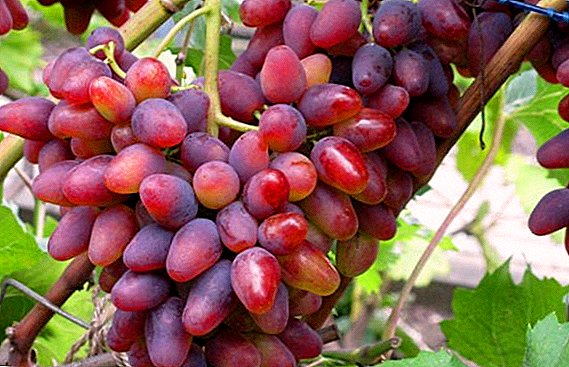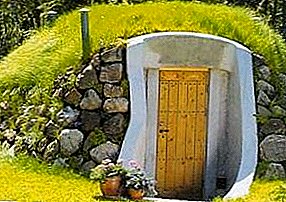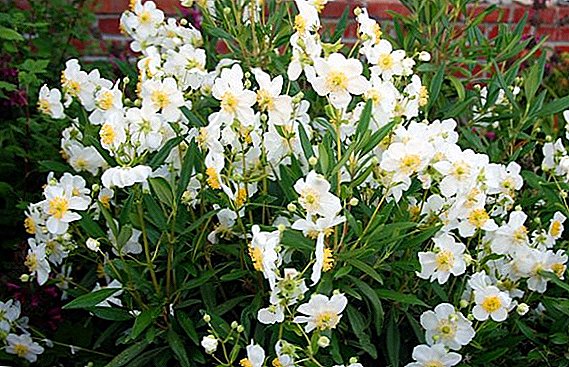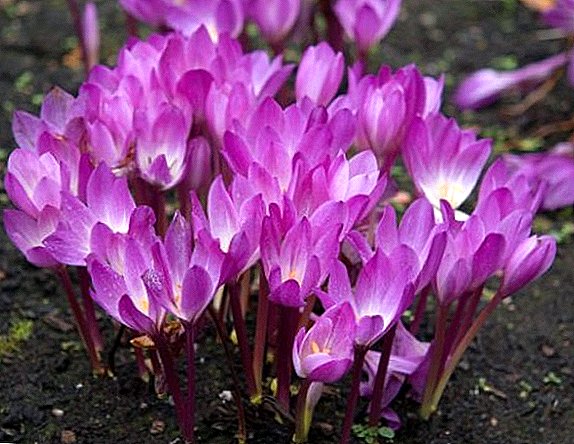 A colchicum, or colchicum, is a perennial bulbous plant that includes many species (only two are common in our country - a magnificent autumn crocus and an autumn crocus autumn). All of them differ in a very unusual life cycle: flowering occurs in late autumn, leaves and fruits form in spring, by summer the plant spreads seeds, after which all of its aboveground parts completely dry to wake up again in autumn. Tuberiform tuberous bulb is used for medicinal purposes.
A colchicum, or colchicum, is a perennial bulbous plant that includes many species (only two are common in our country - a magnificent autumn crocus and an autumn crocus autumn). All of them differ in a very unusual life cycle: flowering occurs in late autumn, leaves and fruits form in spring, by summer the plant spreads seeds, after which all of its aboveground parts completely dry to wake up again in autumn. Tuberiform tuberous bulb is used for medicinal purposes.
Did you know? There is a huge number of popular names for this herbaceous plant, indicating either a specific developmental cycle or that the autumn crocus is poisonous. So, it is sometimes called the untimely color, autumn color, autumnal, wintering, as well as "dog death" and "fatherless son." In Europe, autumn crocus is known as meadow saffron. The British, for the lack of leaves at the time of flowering, called the plant "naked lady." But the name Kolhikum has geographical roots. Kolkhida among the ancient Greeks was called the historical region of western Transcaucasia, now it is the territory of Georgia. The Greeks believed that Kolkhikum grew out of the drops of blood falling to the ground of Prometheus, the protector of people from the arbitrariness of the gods.Today an autumn crocus is grown both for ornamental purposes and as a medicinal raw material.
The chemical composition of autumn crocus
A huge amount of alkaloids is found in various autumn crocus organs.. A total of more than two dozen, but among the main can be called colchicine, kolhamin and kolkhitsein.
 Colchicine tends to inhibit the movement of white blood cells to the site of inflammation, slow down cell division, block the inflammation of skeletal muscles, and restore protein metabolism. The alkaloid is very effective in treating acute attacks of gout. In autumn crocus bulbs of this substance contains about 0.7%, slightly more in flowers, and in seeds - up to 1.2%.
Colchicine tends to inhibit the movement of white blood cells to the site of inflammation, slow down cell division, block the inflammation of skeletal muscles, and restore protein metabolism. The alkaloid is very effective in treating acute attacks of gout. In autumn crocus bulbs of this substance contains about 0.7%, slightly more in flowers, and in seeds - up to 1.2%.
Kolhamin is similar to colchicine in its properties, but it is much less poisonous. Kolkhitsein is used mainly for receiving various colchicine derivatives.
In addition to the three above mentioned alkaloids, glycoalkaloids, aromatic acids, flavonoids (apigenin), sterols and sugars are also included in the collar tea. The seeds of the plant, in addition, contain resins, tannins, lipids. Having such a chemical composition, colony has many medicinal properties.
The healing properties of autumn crocus
The beneficial properties of the autumn crocus are primarily associated with the colchicine and colchamine released from its tuber-bones.
Thus, colchicine, extracted from the autumn crocus, is produced in the form of tablets, which are prescribed for the treatment and prevention of gout, gouty arthritis, as well as phlebitis (inflammation of the vein wall), disorders of protein metabolism, some diseases of the joints (chondrocalcinosis), as well as such "exotic" diseases like scleroderma, mediterranean fever and some others. In addition, the drug is used to treat inflammation in dentistry and otolaryngology.  As for kolhamina, its main purpose - the fight against cancer of the esophagus and the upper third of the stomach, in cases where surgery is impossible. As an ointment, kolhamin is successfully used to treat some forms of skin cancer in the early stages. This alkaloid is capable of killing atypical cells and, as mentioned above, is less toxic than colchicine. The substance should be used with caution, because it causes gastric disorders, lowers blood pressure, slows the formation of leukocytes and lymphocytes and at the same time tends to accumulate in the body.
As for kolhamina, its main purpose - the fight against cancer of the esophagus and the upper third of the stomach, in cases where surgery is impossible. As an ointment, kolhamin is successfully used to treat some forms of skin cancer in the early stages. This alkaloid is capable of killing atypical cells and, as mentioned above, is less toxic than colchicine. The substance should be used with caution, because it causes gastric disorders, lowers blood pressure, slows the formation of leukocytes and lymphocytes and at the same time tends to accumulate in the body.
Did you know? The healing properties of the colchicum were noticed a long time ago, the healers of ancient Egypt, India and Greece wrote about the plant. During the Middle Ages, autumn crocus was used to treat wounds and reduce pain in joints and bones, and also as a diuretic as an additional ingredient. But at the same time side effects were noted in the form of diarrhea, as well as, oddly enough, an increase in sexual activity. The pharmacological industry of Great Britain used the plant from the beginning of the 17th century to the 20th century to make preparations for rheumatism, gout and various neuralgic diseases, however, at present, these drugs have been discontinued due to low efficiency against the background of pronounced side effects.Despite the fact that we are talking about a very poisonous plant, autumn crocus is nevertheless used in folk medicine as a laxative and diuretic, as well as, if necessary, to remove a painful attack or cause vomiting.
Preparation of medicinal raw materials
 As indicated, the medicinal raw material for autumn crocus is primarily the onion. It should be dug along with the roots during the flowering period of the colchicum. It is better to choose the largest tubers. Then the root must be carefully freed from the ground, above-ground parts and the escape of renewal (it is located on the side), after which the corm must be dried. To do this, the raw material is laid out on a horizontal surface in a warm and dry place and with good ventilation. It is possible to store the received raw materials no more than three months with a layer no more than 10 cm in the aired room.
As indicated, the medicinal raw material for autumn crocus is primarily the onion. It should be dug along with the roots during the flowering period of the colchicum. It is better to choose the largest tubers. Then the root must be carefully freed from the ground, above-ground parts and the escape of renewal (it is located on the side), after which the corm must be dried. To do this, the raw material is laid out on a horizontal surface in a warm and dry place and with good ventilation. It is possible to store the received raw materials no more than three months with a layer no more than 10 cm in the aired room.
Important! To wet and, moreover, wash the corms before drying in any case impossible! It is also not recommended to use corms damaged during digging, because such raw materials are poorly stored, quickly begin to rot and become covered with mold.When harvesting raw materials you need to be extremely careful, not forgetting that the plant is very poisonous. In addition, an appropriate warning must be placed on any package in which dried roots will be stored or sold.
Use of autumn crocus in traditional medicine
As was mentioned, colchicum is widely used in traditional medicine, although many knowledgeable people categorically do not recommend the use of this highly toxic raw material for self-treatment, since the danger from such experiments may be much higher than the possible positive effect.
Infusion of autumn crocus
Water infusion of autumn crocus is prepared as follows: the crushed dried root of the plant (not more than 1/2 teaspoon) is poured with boiling water (0.5 l), the resulting mixture is infused for two hours, filtered and pressed. It is applied inside with jaundice, whooping cough, dropsy, aches in the bones against the background of common cold, rheumatic, neuralgic pains, cardiac weakness.
Important! Apply the autumn crocus in the inside should be in minimum doses - start with two drops, gradually increasing their number to eight, and to lower the concentration of a poisonous substance an infusion must be taken with at least a glass of warm water without gas. Eat 40 minutes after eating.To relieve pain and relieve inflammation, an infusion of fresh harvested roots can be prepared in the same way. It can be used as an external agent (for rubbing or compressing) or inwards up to six times a day while observing the above precautions.
Autumn crocus tincture
 It is noticed that alkaloids contained in the autumn crocus help with rheumatic pains. To do this, you can make an alcoholic tincture of autumn crocus: you need to grind dried corms and pour 50% ethanol in a 1: 5 ratio, insist in a dark place for 15 days and use them as lotions and compresses.
It is noticed that alkaloids contained in the autumn crocus help with rheumatic pains. To do this, you can make an alcoholic tincture of autumn crocus: you need to grind dried corms and pour 50% ethanol in a 1: 5 ratio, insist in a dark place for 15 days and use them as lotions and compresses.
To relieve pain in the joints and back, you can prepare vinegar from autumn crocus according to a similar recipe, mixing dry shredded roots with 9% vinegar at the rate of 1 part of raw materials into 12 parts of vinegar. Insist the same two weeks. Apply as a rubbing in small doses.
For cystitis, edema, urolithiasis, tincture of fresh autumnal crocus is used: raw materials (2 medium sized bulbs) must be rubbed, following the necessary precautions, pour 0.2 l of vodka, the time and conditions of the infusion are the same. Accept inside no more than two drops three times a day, washing it down with plenty of water. The first dose should be taken in even smaller amounts and wait more time to make sure that there are no negative reactions and symptoms of poisoning.
Also in folk medicine, tincture of the autumn crocus is used to alleviate pain: 10 g of seeds should be poured in undiluted ethyl alcohol (125 ml), insisted in a dark place for three weeks, strain. It is used as a rubbing or inward in 1 drop, observing the above precautions. Another recipe for tincture is also known: 1 part of the seeds is poured with 10 parts of a 70% aqueous solution of ethyl alcohol, the infusion time is two weeks. The use of external or internal, the dose can be gradually increased to 20 drops three times a day. Do not forget to drink the drug with plenty of water!
Grinding ointment
 Columbia ointment, as well as an infusion, is used externally to relieve pain in radiculitis, arthritis, rheumatism, gout.
Columbia ointment, as well as an infusion, is used externally to relieve pain in radiculitis, arthritis, rheumatism, gout.
To prepare the ointment, grind 300 g of onions (dry or fresh), pour the slurry with 0.5 l of water and steam in a water bath for half an hour. The finished infusion is drained and mixed with any fat (petroleum jelly, butter, etc.) to form an ointment. Used externally. Store in the refrigerator under tightly closed lid.
Contraindications, symptoms of poisoning and first aid
The use of autumn crocus is very dangerous and has a large number of contraindications.
Preparations based on the autumn crocus cannot be used in the late stages of oncological diseases, with gastric hemorrhages, with a decrease in the blood formation process and in cases of through penetration of malignant tumors into the bronchi. Colchicon is contraindicated for children categorically.
Important! Only 6 g of autumn crocus seeds are capable of killing an adult, for a child this dose is 3-4 times less. Poisoning can occur even after drinking milk from a cow that has eaten a plant. In this case, poisonous substances that are in the autumn crocus are not destroyed by boiling.Collapse in autumn is accompanied by nausea and vomiting, abdominal pain, diarrhea with bloody discharge. In addition, blood pressure decreases, there is arrhythmia, convulsions, decrease in body temperature, paralysis, hallucinations. The first signs appear 2 hours after the poisoning and later, the process is slow, the effects of intoxication are observed within ten days. The most acute phase occurs on the 3-7th day of the disease.
 In case of any suspicion of planting poisoning, take sorbex or activated carbon, wash the stomach with potassium permanganate (0.1% solution) and immediately seek medical attention. It is also recommended to drink plenty of water.
In case of any suspicion of planting poisoning, take sorbex or activated carbon, wash the stomach with potassium permanganate (0.1% solution) and immediately seek medical attention. It is also recommended to drink plenty of water.
The danger of poisoning by crocus when accidentally consumed or used as a medicine is so great that it is strongly not recommended to use this plant for self-treatment by yourself. All the above recipes of traditional medicine in any case should be discussed in great detail with your doctor and only after that make an informed decision about the possibility of such a method of healing.



